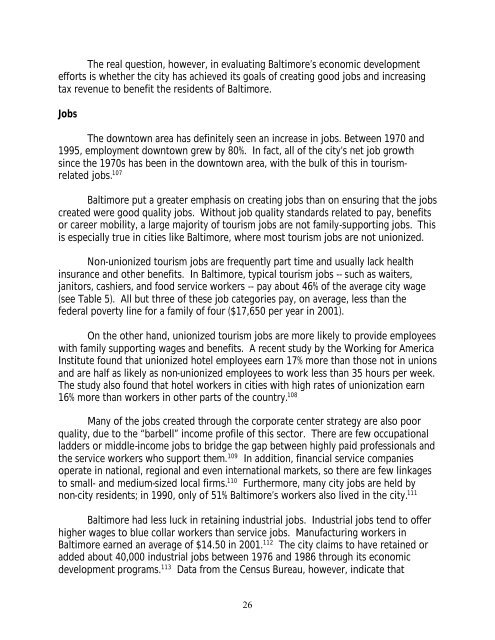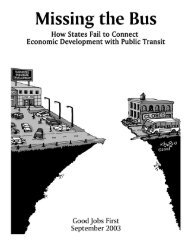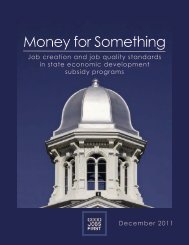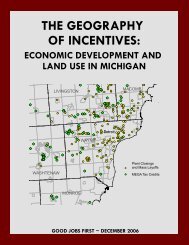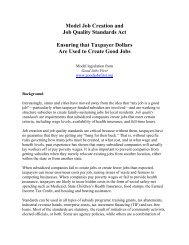Subsidizing the Low Road: Economic ... - Good Jobs First
Subsidizing the Low Road: Economic ... - Good Jobs First
Subsidizing the Low Road: Economic ... - Good Jobs First
Create successful ePaper yourself
Turn your PDF publications into a flip-book with our unique Google optimized e-Paper software.
The real question, however, in evaluating Baltimore’s economic developmentefforts is whe<strong>the</strong>r <strong>the</strong> city has achieved its goals of creating good jobs and increasingtax revenue to benefit <strong>the</strong> residents of Baltimore.<strong>Jobs</strong>The downtown area has definitely seen an increase in jobs. Between 1970 and1995, employment downtown grew by 80%. In fact, all of <strong>the</strong> city’s net job growthsince <strong>the</strong> 1970s has been in <strong>the</strong> downtown area, with <strong>the</strong> bulk of this in tourismrelatedjobs. 107Baltimore put a greater emphasis on creating jobs than on ensuring that <strong>the</strong> jobscreated were good quality jobs. Without job quality standards related to pay, benefitsor career mobility, a large majority of tourism jobs are not family-supporting jobs. Thisis especially true in cities like Baltimore, where most tourism jobs are not unionized.Non-unionized tourism jobs are frequently part time and usually lack healthinsurance and o<strong>the</strong>r benefits. In Baltimore, typical tourism jobs -- such as waiters,janitors, cashiers, and food service workers -- pay about 46% of <strong>the</strong> average city wage(see Table 5). All but three of <strong>the</strong>se job categories pay, on average, less than <strong>the</strong>federal poverty line for a family of four ($17,650 per year in 2001).On <strong>the</strong> o<strong>the</strong>r hand, unionized tourism jobs are more likely to provide employeeswith family supporting wages and benefits. A recent study by <strong>the</strong> Working for AmericaInstitute found that unionized hotel employees earn 17% more than those not in unionsand are half as likely as non-unionized employees to work less than 35 hours per week.The study also found that hotel workers in cities with high rates of unionization earn16% more than workers in o<strong>the</strong>r parts of <strong>the</strong> country. 108Many of <strong>the</strong> jobs created through <strong>the</strong> corporate center strategy are also poorquality, due to <strong>the</strong> “barbell” income profile of this sector. There are few occupationalladders or middle-income jobs to bridge <strong>the</strong> gap between highly paid professionals and<strong>the</strong> service workers who support <strong>the</strong>m. 109 In addition, financial service companiesoperate in national, regional and even international markets, so <strong>the</strong>re are few linkagesto small- and medium-sized local firms. 110 Fur<strong>the</strong>rmore, many city jobs are held bynon-city residents; in 1990, only of 51% Baltimore’s workers also lived in <strong>the</strong> city. 111Baltimore had less luck in retaining industrial jobs. Industrial jobs tend to offerhigher wages to blue collar workers than service jobs. Manufacturing workers inBaltimore earned an average of $14.50 in 2001. 112 The city claims to have retained oradded about 40,000 industrial jobs between 1976 and 1986 through its economicdevelopment programs. 113 Data from <strong>the</strong> Census Bureau, however, indicate that26


